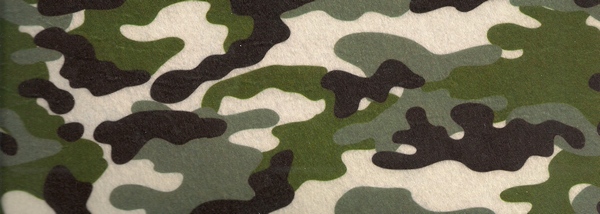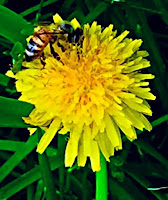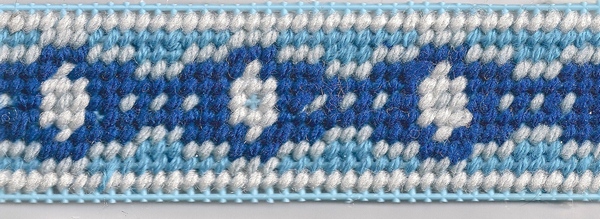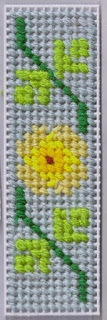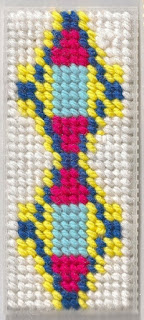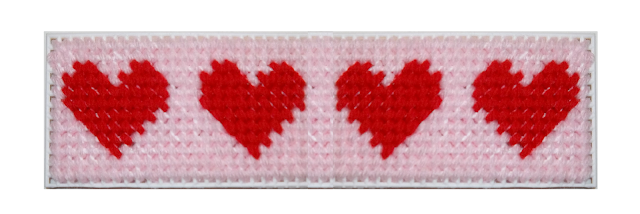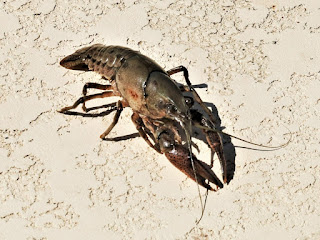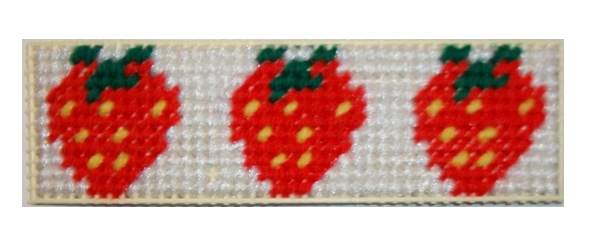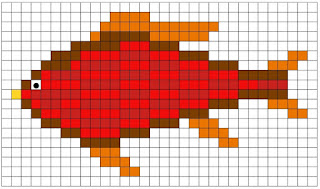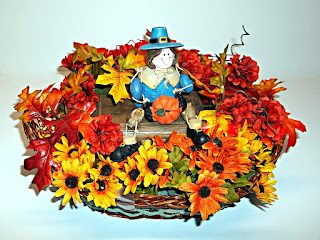
Recently J D. pointed out that I had done a number of sketches, designs, and pieces of needlework involving fish and other water-dwelling creatures, and that perhaps I should "do something" with them. Without giving the matter much serious thought, I replied that I might do a post called "
Something Fishy". I hadn't given the project much thought, until he later asked what I had done about it. I said I had to think about fish before I write about them. I got a long look with a seriously raised eyebrow in reply. "I'm thinking!" I said. His expression suggested that I just might think a little faster. So when, I thought, did I first get interested in fish? (Isn't memory a strange thing?) And there was the memory, as vivid as if I were watching it on a screen.
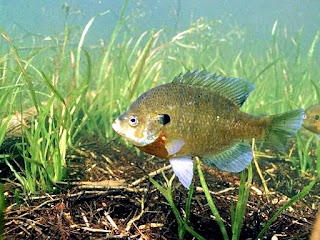 |
Bluegill
|
It was the summer before I turned seven. It was a hot, dry summer. Our well had not run dry, but there was already talk abut hauling water for the livestock from an artesian well in the next township. (We did not have electricity, running water, central heat or indoor plumbing, if you can picture that.) We did have a cistern to catch rainwater, but it had gotten so low that we had already hauled enough water from a spring at the back of the property to refill it. I volunteered to go to the bottom of our big hill and see how the creek that ran there was faring. The creek was no longer running. There were a few pools of water that were rapidly evaporating. In the largest pool I found three colorful fish lying on their sides, just barely alive.
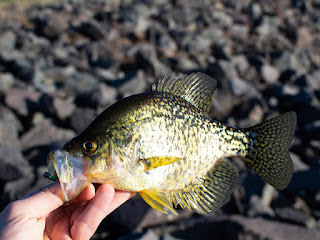 |
Crappie
|
I raced to the top of the hill. Charlie, a teen-aged cousin, was staying with us for a couple of weeks. "Charlie," I cried, "We have to save the fish!" Once he understood, he agreed. We dipped a couple of buckets of the water from the cistern and hurried back down the hill. We carefully lifted the fish from their puddle and hurried to relocate them in the cistern. My dad had been attracted by the commotion. He was a hunter and trapper as well as a farmer, but not much of a fisherman. He identified the fish for us: bluegill, crappie (pronounced croppie), and sunfish. He suspected they came originally from the Wabash River, to which our creek was distantly connected, and mentioned that all three were tasty. Charlie and I both protested that we hadn't saved their lives just to turn around and eat them!
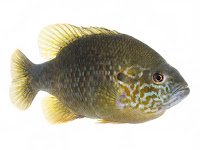 |
Green Sunfish
|
Dad agreed good-naturedly and we three set about catching flies, mosquitoes, earthworms, any any other handy tidbits to feed the fish. We kept that up for two more days, between chores. And then Nature relented and produced a spectacular thunderstorm and two full days of rain, through which we slogged to care for the livestock. We carried the fish back to the creek and released them. They swam away in three different directions, apparently anxious to end their forced association.
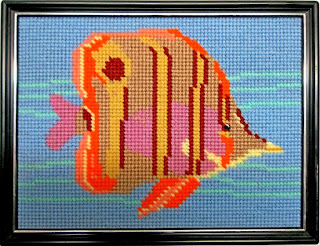 |
Tropical fish needlepoint
|
A couple of decades later I was the head of a science department in a junior high school in northern Virginia. One of our favorite field trip destinations was the National Aquarium in Washington D.C., which was then housed in the Department of Commerce Building. By that time I had flown back and forth across the Atlantic, seen the coast of Newfoundland, gotten acquainted with the North Sea from Holland, and gotten a glimpse pf the Irish Sea, but I hadn't seen the creatures that lived in those waters. So I also visited the National Aquarium on my own, content to sit for hours. sketching or just watching the infinite variety of fish. Those are also good memories. But, like today, those were turbulent times, and eventually we were forbidden to take field trips into D.C. because of the dangers from riots. Perhaps it is that memory that has been what has turned my eyes and hands to depictions of fish recently.
When you are showing a fish like this, its shape and colors make it stand out. Then you are left with the problem of what to do with all that background around it. You can, of course, just paint or stitch a flat background in a single color, as if the fish were stuffed and mounted, but that isn't very interesting. I prefer to at least suggest the water through which the fish is swimming. This is the simplest way to do that. Just use several closely related shades of blue in the watery background, varying the concentration of of each shade so that the water doesn't look like it has stripes.

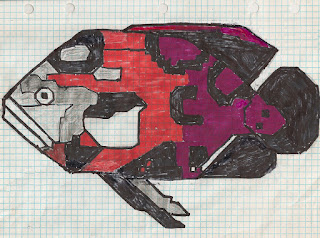 |
Rough pattern for oscar needlepoint
|
This is a color sketch for an Oscar. Oscars are cichlids, freshwater fish originally from South America, which have now been established in parts of Asia and Australia. These fish have become very popular for personal aquariums. Many are smaller than this one, which is depicted (on an 8.5" x 11" sheet) at about the size limit You can feel free to make the fish in any color scheme you like. If there isn't one like it in captivity, no doubt one will be discovered — or bred — sometime soon. There are multitudes of color photos online if you want to do a realistic rendering. I 'squared-off' some features in order to make a needlepoint picture of the fish which I worked on a standard canvas.
 |
Oscar needlepoint
|
I chose to put my fish in shallow water, lit from above with sunlight, and to surround it with suggestions of different species of water plants. Their unusual colors and patterns, despite their brightness, break up the fish's outline and provide good camouflage. Some species can also change color to some extent. It is a hunter and has even been described lying flat on one side and "playing dead" to attract its prey. In aquariums they are usually fed crustaceans, earthworms, insects and specially prepared mixtures that are designed to be fed to much larger carnivorous fish.
My memory served up another delight. We were living in Idaho at the time. My husband had some leave time, so we had gone to a weekend affair in the Grand Tetons. We both liked to fish, but he wouldn't eat the fish so we went to "catch and release" before it was even popular. We always had fishing gear in the back of the van, even when we weren't pulling the boat. So we decided to stop at a reservoir on the way home to see how fast the ice was melting. There was about a three foot stretch of open water, so we took our gear and started along the embankment. We met a lone fisherman and he and my husband started talking. I moved on quite a way ahead of them.
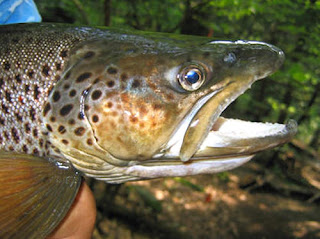 |
Brown trout
|
The water was as clear as glass. I could see a big brown trout — my favorite trout — on the bottom. I had a small red and white lure with a lot of action to it on my line, so I dropped it gently on the surface some distance ahead of the brown and started twitching it every few seconds. I watched him come up from the bottom, opening his mouth wide as he hit the lure. I set the hook. He fought me the short distance to the shore. My shout as I lifted him out of the water brought the two men running. The brown was indeed a beautiful fish. He wasn't badly hooked, and was soon freed. I took him back to the edge and eased him into the frigid water, watching him until he disappeared under the ice. It was one of those small, perfect moments that you remember forever.

I am often asked for border designs for embroidery, and so have used several in this article. I hope you will find them useful. These are designed for linear stitches like outline and chain stitches. The figures can all face one direction or be used in face-to-face positions alternating with tail-to-tail pairs.
But counted cross-stitch and needlepoint can also be used for larger panels and borders. Here is a segment of a repeatable design that can be done in either of those techniques. If you are going to do needlepoint on a fabric background, use the kind of canvas that is designed to be pulled out when the design is completed and don't pull your stitches so tight that the canvas threads cannot be removed. If this technique is new for you, I recommend you practice on a piece of the canvas and fabric before you undertake a larger composition. Check the work from time to time to make sure your stitches are not getting tighter as you go along, because that is an easy mistake to make.
Fishing can, of course, be frustrating, especially when the fish aren't biting. But I remember one occasion when it was frustrating because the fish
was biting. No, that is not an error in grammar. Let me explain. It was during the time when we were stationed in Panama. My husband wanted to try fishing from a solitary dock on the Pacific side of the Isthmus. I went along to keep him company. It was a nice
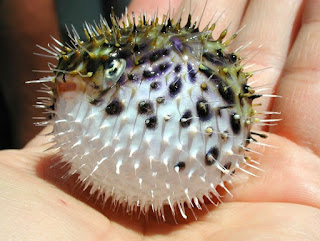 |
Tiny, spiny puffer fish
|
day and I was enjoying watching the water birds skim and dive to do their fishing. My husband was not getting any action. Finally he got a strong tug on his line. The fish put up a good fight, but he finally brought it in. Much to his dismay, it was a small puffer fish that had swallowed enough water to become the size of a football. There are quite a number of these species in tropical and sub-tropical waters. This was one of the kind that, when inflated, was covered with sharp spines poking out of its skin in all directions and was able to deliver a poison if handled improperly.* He put on heavy gloves and freed the fish from the hook. It was obviously not the first time it had been hooked because it had a distinct scar on one side of its jaw. He took it to the far end of the dock and dropped it back into the water. Twenty minutes or so later, he got another strike and reeled in the fish. He groaned, "It's another one!" "No," I said, pointing to the scar, "it's the same one." He decided that the third time had to be the charm he needed. Another twenty minutes. Another strike. Same fish. (I really thought it looked ashamed that time, but it was probably just water-logged.) My husband announced that since there was apparently only one fish left in the water that the birds hadn't eaten, we might as well go home. So we did. And I managed not to laugh once, at least not out loud.
*Not all puffer fish produce the potentially deadly tetrodotoxin, but, if you encounter one, it is probably best to assume that it does. The toxin is also found in other fish like porcupine fish, triggerfish, and ocean sunfish, snails and other mollusks, some crabs and sea urchins. On land, it is found in some newts, toads, and frogs. The deadliest carrier of the toxin is the blue-ringed octopus.
 |
Panama Canal. Pacific end
|
The Panama Canal has caused a lot of problems for local populations of fish and other aquatic or marine creatures. Pacific species, long held back by the unbroken shoreline, invaded the Atlantic Ocean and Atlantic species did the same thing to the Pacific Ocean. These transfers, no longer in a controlled environment, affected not only the species themselves, but also the organisms which ate them or were eaten by them. Some species have disappeared completely and some of the "foreign" species have spread widely, affecting areas a long distance from the Canal itself.
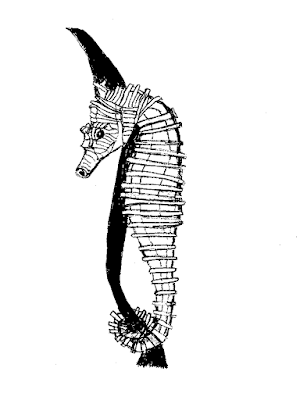 |
Seahorse drawing by Annake
|
Here is a big drawing of a very small fish. I think that if I had to choose just one kind of fish to study and draw it would be the seahorses and the related — and even stranger — sea dragons. These are among the most fascinating of sea creatures, both in appearance and in habits. many people don't even realize that they are fish.
But there are many species of sea creatures on tropical coral reefs, under the polar ice, and at the bottom of the seas that are little known or understood, if they have even been discovered. And many of them are in danger of extinction before they have even been studied. The effects of climate change have been magnified and multiplied by our failure to understand and protect the lives of these creatures, many of whom have survived millions, even billions, of years of planetary changes before we ever existed. The damage that has been done to both freshwater and saltwater habitats in just the past couple of centuries is appalling. However, I am greatly encouraged by the growing interest among teenagers and young adults in combating these problems. They are taking a global approach toward the problems and are prepared to work cooperatively to overcome them. I hope all of us will get behind their efforts and support them in any way we can.
Stay well. Stay safe. Stay positive.

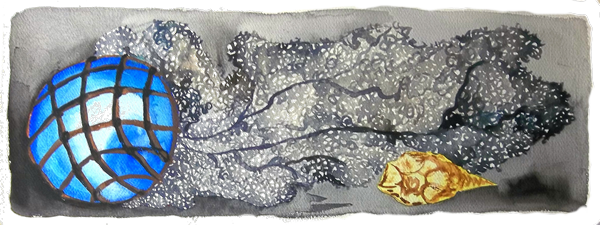
 This post by Annake's Garden is licensed under a Creative Commons Attribution-NonCommercial-ShareAlike 3.0 Unported License.
This post by Annake's Garden is licensed under a Creative Commons Attribution-NonCommercial-ShareAlike 3.0 Unported License.



 This post by Annake's Garden is licensed under a Creative Commons Attribution-NonCommercial-ShareAlike 3.0 Unported License.
This post by Annake's Garden is licensed under a Creative Commons Attribution-NonCommercial-ShareAlike 3.0 Unported License.








